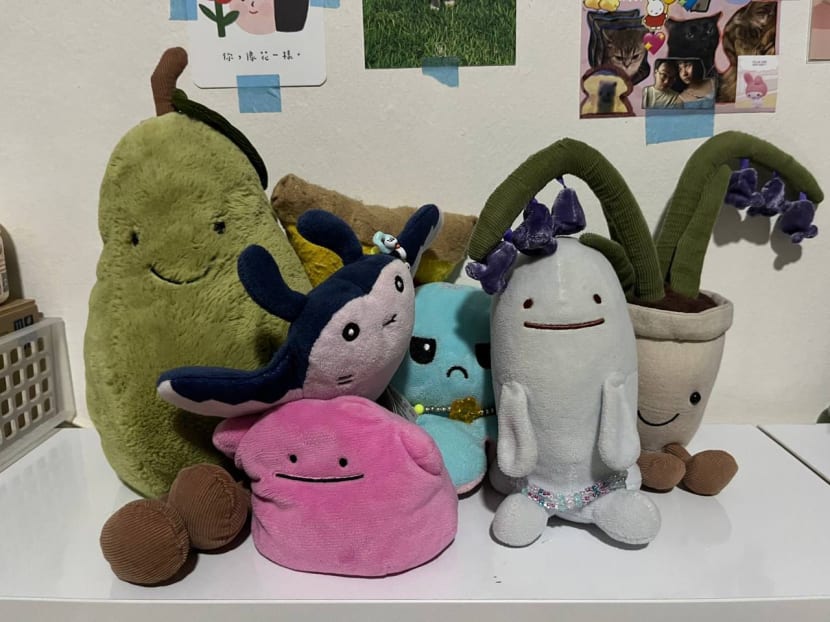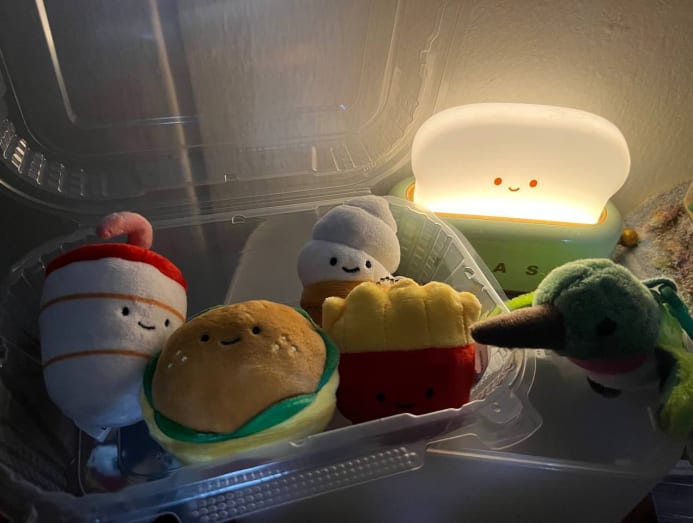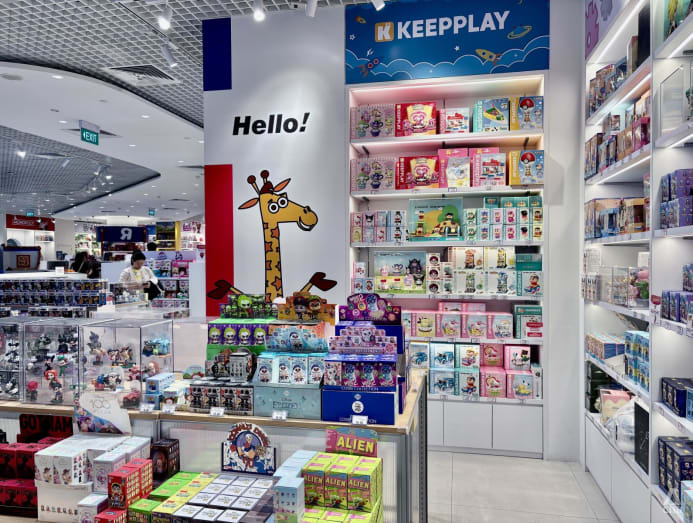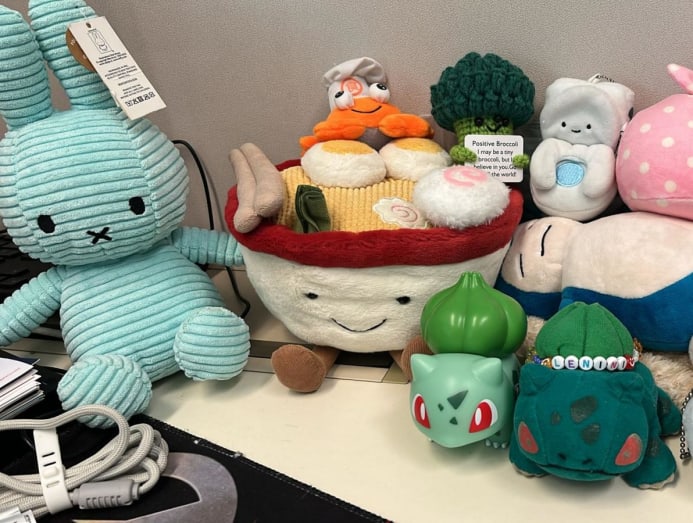Why are millennials buying plushies and ‘cute stuff’? It’s to heal their inner child
Nostalgia isn't the only emotion behind the growing trend of adults spending on children's toys. The "kidult" phenomenon, more fundamentally, seeks to reclaim joy and play – elements that are often lost in adulthood.

A few plushies in 31-year-old Nicole Goh's beloved collection. (Photo: Nicole Goh)

This audio is generated by an AI tool.
Between Tan Peng Sing and Nicole Goh, the Singaporean millennial couple and soft toy enthusiasts have just over 80 plushies.
Goh, 31 this year, estimates around 20 in her collection that include larger keychains. She acquired her plushies during different phases of life, most being gifts from friends or Tan, so each holds significant meaning.
Tan, on the other hand, presently owns 63 plushies, which include 30 from his childhood that he has vacuum-packed for storage. Making up his collection are the remaining 23 at home – one is a “giant My Melody head” belonging to Goh – and 10 on his office desk.
One of the couple’s current obsessions is Japanese gachapon brand Qualia Tokyo because its collectibles are “miniaturised versions” of everyday, mundane objects, like scissors, fries, poop and microbes. In fact, “the weirder, the better”, Tan said, describing the toys that tend to steal his heart.
“I also don’t want them to have too much facial expression. They must have the ‘no thoughts, head empty’ face,” the 36-year-old added.

Qualia Tokyo’s plushies fit the criteria with their dotted eyes and slight smile. It’s an endearing “aesthetic” that can instantly brighten up one’s day, which Tan and Goh have also observed in plushies produced by British soft toy company Jellycat.
While the brand’s charming and diverse plushies have long appealed to children and adult collectors, its cult following catapulted into the mainstream global spotlight following its pop-up at luxury department store Selfridges in London last year.
Inspired by the classic British dish of fish and chips, the collectible plushies at the event resembled different items in a standard meal. There was battered cod fish, a packet of chips, mushy peas, a lemon wedge, and salt and vinegar shakers – all with Jellycat’s signature irresistible cuteness.
The pop-up went viral, however, because of the pretend play involved in each customer’s purchase.
Social media videos showed Jellycat employees lifting the battered cod plushie from a deep fryer and laying it onto greaseproof paper. They then sprinkled salt and squeezed lemon – from the salt and lemon plushies, obviously – over the fish. Once the fish was seasoned, they wrapped it up and handed it to the customer with a warning that the “food” was still piping hot.
Most importantly, Jellycat employees stayed in character throughout the demonstration. It might be make-believe, but the joy and amusement on the faces of their mostly adult customers couldn’t be more real.
THE REINVENTION OF THE “KIDULT”
Other brands have since recreated such retail experiences with Jellycat lookalikes to similar success.
For instance, a pop-up by Malaysia food and beverage brand Bungkus Kaw Kaw at Sunway Pyramid mall in Selangor earlier this month went viral for its nasi lemak plushie, with the individual “ingredients” assembled by an enthusiastic “hawker”.
It didn’t matter that the event happened across the world from Jellycat’s Selfridges pop-up. It appeared many of the customers queuing for a nasi lemak plushie were also “kidults” – a term that broadly refers to adults who enjoy toys, games and other entertainment typically intended for children.
Even though kidults aren’t a new subculture, it seems to have taken on a new life among millennials. One viral Instagram Reel created last year posed the question: Millennials, have we decided what our mid-life crisis stereotype is going to be?
"I think it’s just buying cute stuff,” a creator replied in the video.
“I don’t need a Ferrari or anything like that, but I do need an octopus that reflects my mood right. I need a toast lamp that I can turn on when I want to focus on work and call it my focus toast. I need a llama that my cat can sleep in. I need a print of a banana knitting on the subway. And honestly I think it’s working; I think it’s filling the void. So I’ll take it,” she said, showcasing her collection.
Several commenters highlighted that finally having the money to buy the toys they couldn’t when they were young was a way to “heal their inner child”, while others half-jokingly said they thought they were alone in their obsessions.
Retail branding expert Tim Nash told CNA Lifestyle that the Reel, while humorous, is a “window into a deeper societal narrative” around the unique challenges that millennials grapple with.
The generation has come of age during a period when traditional markers of adulthood like homeownership, stable careers and family often feel “out of reach”, said Nash who’s based in the UK.
“Is ‘cute stuff’ the answer? Of course not. But it’s a symbol of something more profound. It represents a desire to reconnect with a time when life felt less complicated. It’s a tangible expression of yearning for joy in a world that often feels overwhelming.”
The overarching sentiment is clear: The kidult phenomenon is far from child’s play.
FUELLED BY SPENDING POWER
Nowhere was this more evident than in the Labubu craze starting last year, where the elvish doll skyrocketed to global collector’s item status overnight – thanks in part to Blackpink’s Lisa, who flaunted her own Labubu and love for Pop Mart’s blind boxes.
This frenzy propelled the broader blind box trend, turning Chinese retailer Pop Mart into the largest and fastest-growing enterprise in the trendy toy industry last year.
Relatedly, the toys and hobbies category in TikTok Shop grew six times in gross merchandise value and saw a 30 per cent increase in merchants as of January 2025, compared with the same period in 2024, the platform told CNA Lifestyle.
But while trendy toys are having their moment in the spotlight, it’d be a mistake to dismiss their appeal as just a passing fad – or one that won’t return time and again.
“Nostalgia is a remarkably powerful force that often resurfaces every few years. This recurrence taps into fond memories from childhood ... For some, these memories are associated with memorable items that their parents once bought them,” explained Joselyn Sim from LASALLE College of the Arts, University of the Arts Singapore.
These individuals, now adults with purchasing power, might “seek to reconnect with these cherished memories by acquiring these items or similar ones they once had”, said Sim, the programme leader for the masters in design.

This behaviour is also linked to “recessionary comfort buying”, where familiar childhood icons are “reintroduced as premium or limited-edition collectibles, often marketed towards the now-adult fanbase”, added David Lee, a lecturer in design communication at LASALLE.
“Think of how Hello Kitty, Pokemon, Tamagotchi and Beanie Babies were massive in the late ‘90s and early 2000s. Now we see similar hype around Pop Mart’s Hirono blind box series or the luxe plush toy offerings of Jellycat.”
SHIFT IN VISUAL MERCHANDISING
With the growing kidult demographic, the retail experience is likely to evolve as well – from pop-ups like Jellycat’s in London to store revamps – as brands adapt to thrive.
A traditional toy store may now be increasingly seen as “a lifestyle or pop culture destination”, like Pop Mart’s flagship store at ION Orchard, rejuvenating the children’s toy industry “in a more inclusive way”, observed Shannon Sim, programme leader for the bachelor of arts in fashion media and industries at LASALLE.
Toys R Us Singapore has also “strategically reimagined” outlets to focus on experiential retail in the last few years. These “next-gen” concepts prioritise “interactive engagement, immersive zones and curated assortments tailored to the changing expectations of customers”, said Adelene Teo, general manager for Singapore, Brunei and Thailand.
At the VivoCity, Paragon and Jewel Changi Airport stores, for instance, blind boxes have been repositioned to greet customers at the store entrance – to everyone’s delight.
“Far from being a passing trend, the kidult market is here to stay. This demographic now represents a growing percentage of our sales. Our early successes – such as the strong performance of blind boxes, exclusive collectibles and interactive in-store experiences – are clear indicators of this sustained interest,” added Teo.

But capturing the hearts and wallets of the kidult market won’t be about simply selling cuter products or making a store Instagrammable in the long run. Brands now need to sell “a feeling, a sense of belonging, a connection to something larger than oneself”, said Nash, who heads the Ignite division at IPOS, a UK-based creative agency specialising in retail branding.
The key is understanding the kidult mindset, as the average kidult isn’t looking for mere products but experiences.
They would be drawn to retail spaces that help them “escape the pressures of modern life, even for just a moment, and reconnect with our inner child”, explained Nash.
“This means a fundamental shift in how we approach visual merchandising and brand experiences. Forget sterile displays and transactional layouts. We’re talking about creating worlds within stores."
He likened pop-ups to theatrical productions, each element curated to evoke a specific emotion or memory. Selling Jellycat plushies by recreating a whimsical bakery, for example, with kidults role-playing as chefs handling plush creations is "performance art".
RECLAIMING JOY, THE RIGHT TO PLAY
And these “performances” seem to have stuck with Tan and Goh, the Singaporean couple with a soft spot for Jellycat collectibles and lookalikes, at least from what they see online.
“I adore watching videos of the (Jellycat) pop-ups where the staff curate and pick the Jellycat (plushies), treating them as actual food. It tickles my brain in a satisfying way,” said Goh.
The couple can't quite explain why Labubu and other blind box toys don't fulfil their "cute" standards, though it's evident they look for some form of “aww-inducing” aesthetic and, occasionally, character backstory.
Tan highlighted Sumikko Gurashi – a set of roly poly characters by Japanese company San-X – whose appeal is that “all the characters have some miserable yet relatable backstory around unfulfilled aspirations, which only adults stuck in the 9-to-5 grind will understand”.

“I have some fuzzy early memories of my mother using soft toys to make me laugh, and somehow it ended up becoming a ‘self-soothing’ thing for me. I just feel so happy and wholesome when I see all of them seated in a corner,” he added.
So while nostalgia may be a significant emotion driving the typical kidult, the phenomenon is more crucially about “reclaiming the right to play, be joyful and embrace our inner child, regardless of age” – essential elements that have been lost at the altar of adulthood’s digital productivity and efficiency, Nash believes.
Toys, tactile and tangible in nature, reconnect us to the physical world, he added. “So this isn't just a trend. It’s a cultural correction, a rebalancing of our lives, a recognition that play is not a luxury, but a necessity."
In the decision-making process, it doesn’t matter that a toy may be functionally useless. After all, children don’t have such concerns either.
All that matters is the happiness it brings – which kidults spending on "cute stuff" know too well that money can buy.









